By Chris Kilham
Issue
120 of HerbalGram contained the feature
article “Ayahuasca Vine Harvesting in the Peruvian Amazon” that detailed
work conducted by my Peruvian research team and me to assess the supply of
ayahuasca vine (Banisteriopsis caapi, Malpighiaceae) in Peru’s Loreto
and Ucayali departments, where ayahuasca activity is heavily concentrated. The
report described findings from two study trips conducted in January and June 2018.
After
that article was published, our team conducted two more research expeditions to
collect new information. The first of those was in December 2018 in the
Pucallpa area in Ucayali department. On both trips, my team members included
long-time traveling partner Sergio Cam of Chakarunas Trading Company, boat
captain Jaime Baca, and Shipibo agroforestry engineering student Kleylie
Vargas.
Ayahuasca,
a psychedelic brew made from ayahuasca vine and other
psychoactive plants, usually the leaves of chakruna (Psychotria
viridis, Rubiaceae) or huambisa (Diplopterys cabrerana,
Malpighiaceae), is now highly popular in Peru and other areas of the Amazon. It
also is brewed and exported for increasingly popular ceremonial use in the
United States and elsewhere. Ayahuasca has
been employed for healing and divination in the Amazon rainforest by various
native groups for centuries.
Popular
media, music, and film celebrities and two Brazil-based ayahuasca churches,
Santo Daime and União do Vegetal, have significantly boosted interest in the
brew beyond its native range. Over the past few years, many people have
expressed concern that the vine, which needs at least five years to reach
maturity, may be imperiled due to overharvesting. Our intention was to
investigate ayahuasca forest harvesting and cultivation in Peru’s Loreto and
Ucayali departments to assess the population status of the vine.
One
piece of the chain of ayahuasca trade we had not seen was the arrival of
forest-harvested vine to the port of Pucallpa, the main trading center for vine
going to both the Pucallpa and Iquitos areas. Vine that comes into Pucallpa is
purchased by local ayahuasceros (ayahuasca
shamans) and ayahuasca brewers, and a great deal of the vine is forwarded on to
ayahuasca centers in the Iquitos area. We contacted Antonio Cauper, a harvester
from Junin Pablo on the Rio Tamaya with whom we had spent time on our second
research trip. Antonio informed us that he would be heading into Pucallpa with a
load of vine, so we arranged to meet him.
Late
morning on a Thursday, Antonio arrived into port on a rapido. So named because they are fast boats, rapidos ply the Ucayali River, acting
as buses and taxis, delivering people and goods from one area to another. Rapidos are economical and are used
by most people living on or near the rivers to get around. Antonio previously had
told us that when he brings a boatload of vine to Pucallpa, he is spotted
easily by buyers who work the waterfront. The Pucallpa waterfront is a chaos of
boats, both small and large, many hauling cargo, and large vessels carrying
hundreds of passengers at a time north to Iquitos along the Ucayali River.
Vendors sell food along the shore, and laborers carry goods to and from boats.
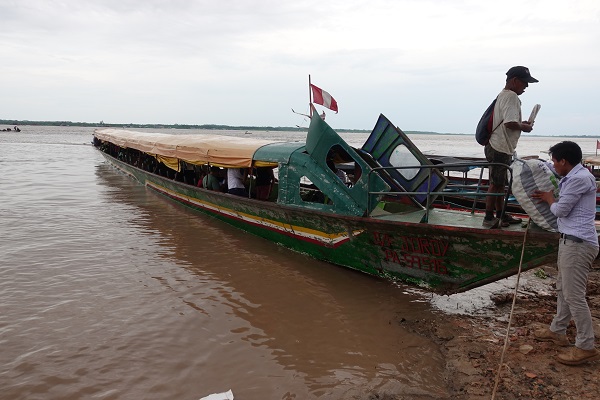
A rapido at the Port of Pucallpa
Antonio
arrived with eight 30-kg (66-lb) bundles of vine. The rapido had no special cargo space, so the vine was packed
between seats. The cost of transport per bundle from Junin Pablo to Pucallpa
was 5 soles, or $1.50.
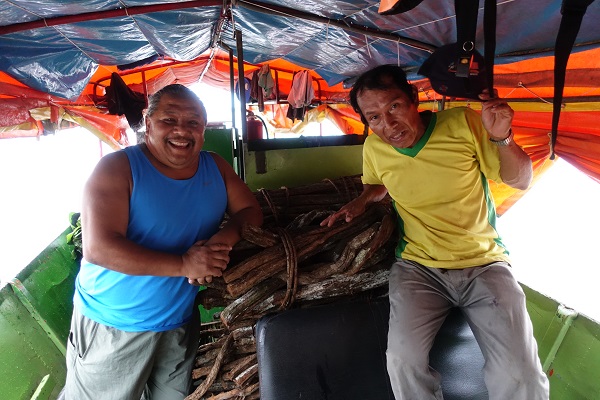
Sergio Cam, Antonio Cauper, and ayahuasca
vine on a rapido.
Once
Antonio’s rapido arrived, a
couple dozen passengers disembarked, and porters went on board to unload cargo.
One man hauled out the eight bundles of vine, one bundle at a time, for 1 sol
each, or $0.30.
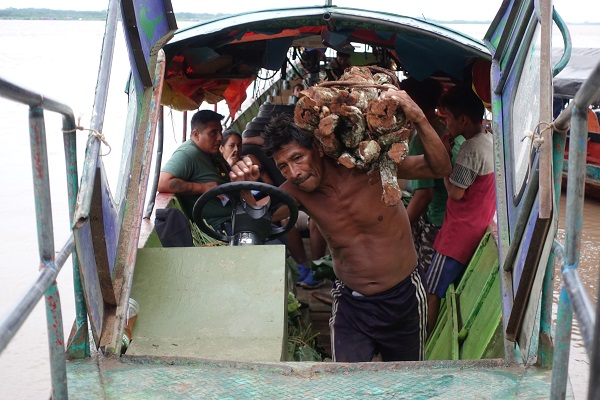
A porter carries vine from a
rapido.
Antonio
already had arranged to supply this particular load of vine to a specific
customer. So, instead of waiting for buyers to spot him, he had the ayahuasca
loaded onto a moto, or moto-taxi. The
moto is the most popular and economical conveyance in Amazon cities, and these
vehicles are used to carry people and goods of all sorts.
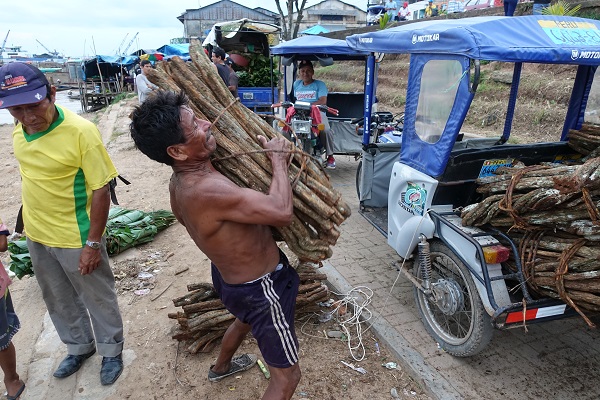
The porter loads vine onto a moto.
A Second Conversation with
Francis Chauca
After
the arrival of Antonio’s load of vine, we headed across Pucallpa to see Francis
Chauca, who I mistakenly referred to as Carlos in the first report. Francis
runs a warehouse for medicinal plants and is most likely the largest supplier of
cat’s claw (Uncaria tomentosa,
Rubiaceae) in the Pucallpa area. Francis recently had purchased 586
hectares of land near Chanajao on the Ucayali River for a biodiversity project
that will include large-scale cultivation of ayahuasca vine, as well as
chakruna. As we learned on our first two trips, more people either are cultivating
ayahuasca or have plans to grow the vine. In our conversations with people who
trade plants, we learned that ayahuasca vine cultivation is very much on the
minds of traders who see a long future market for ayahuasca.
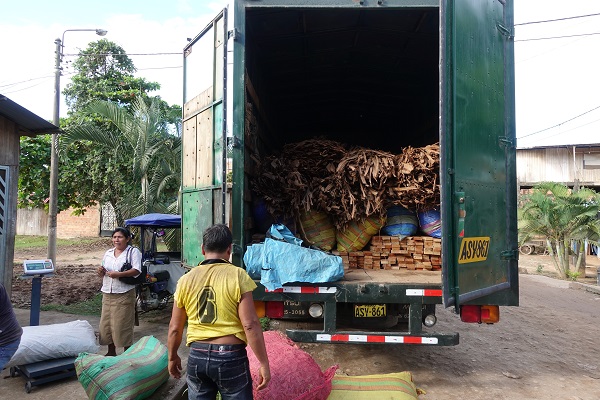
A truck loaded with cat’s claw
at Francis Chauca’s warehouse.
To Lago Imiria
In
April 2019, our team returned to the village of Junin Pablo on the Rio Tamaya,
where we had visited in June 2018. The five-hour boat trip from Pucallpa to the
village offered a thrilling display of wildlife, from many gray and pink river
dolphins, to raptors, parrots, and herons, and even a sighting of a giant
anteater. While most rivers have experienced a grave decline of wildlife, the
Rio Tamaya has been devastated less than other nearby areas. I know that will
change in time, as wildlife poachers concentrate more on that region. But for
now, traveling that river affords a splendid view of fauna and flora.
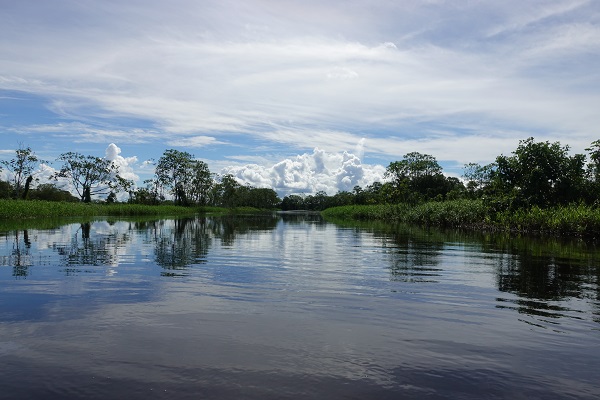
The Rio Tamaya
Kleylie,
who grew up along the Rio Tamaya, had called a few friends and family before
our departure and had received word that many robberies were happening on the
Rio Tamaya. The river is busy with loggers, narcos (drug dealers), and robbers.
We kept alert but encountered no problems as we rode along.
Once
back in Junin Pablo, we checked into Hostel Lobo, an accommodation that offered
basic shelter but little comfort. Kleylie located a woman nearby who would boil
water for our morning coffee, and we learned how to raise buckets of water from
a nearby well for morning bathing and to flush the dry toilet. We re-connected
with two harvesters we had met previously, Matteo Teco and Antonio Cauper. Antonio
has turned out to be one of our most reliable contacts, and we arranged to go
into the forest with him to see wild harvesting of vine and observe the density
of the vine.
Antonio
and Matteo collect vine in two primary areas in the nearby forest. One area is near
Lago Imiria, also known as the Imiria Lagoon. The other is Chauya, another body
of water to the east of Imiria. Lago Imiria can be accessed readily by cutting
the profuse lilies that grow all around its borders. Chauya is more difficult
to reach because the floating waterway borders open and close constantly.
Antonio told us that he has gone to Chauya a few times to collect vine, only to
wind up lost, as the waterways he traveled to get there had disappeared in a
day.
According
to both Matteo and Antonio, Lago Imiria has a good amount of vine. But Chauya,
they both say, is far richer in vine. Matteo says that he prefers to harvest in
Chauya, while Antonio favors Lago Imiria. Both commented that while the forest
areas around both Lago Imiria and Chauya contain a super abundance of ayahuasca
vine, it is not possible to harvest just anywhere, as the forests are populated
by narcos who work plots of coca (Erythroxylum
coca, Erythroxylaceae), which are five to 15 hectares in size, and cook the
coca in the jungle. The narcos have automatic weapons and jealously guard their
plots. Antonio says that he occasionally lets the narcos know that he is a
local harvesting vine nearby in the forest.
Early
on a Friday morning, we got into our boat with Antonio, his son Nixon, and his
daughter Sabina. Armed with machetes, oranges for snacks, and bags for carrying
out wild fruits, we headed for Lago Imiria. In a sparsely populated region,
Imiria is a majestic body of water, sparkling clean and with abundant fish and
birds. The lake is 22 km long and approximately 0.6 km wide, is part of a 135,000-hectare
Area of Regional Conservation, and is home to mahogany (Swietenia spp.,
Meliaceae) and cedar (Cedrus spp., Pinaceae) forests, 15 islands covered
with vegetation, and a wealth of ayahuasca vine. The shores of the lake are
dense with aquatic plants including the reddish yellow imiria lily, after which
the lake is named, plus an abundance of lotuses (Nymphaea spp., Nymphaeaceae). These shores move
about, opening and closing lanes of travel.

The majestic Lago Imiria
After
traveling on the glistening lake for a few miles, we nosed into an open spot on
the shore and tied our boat to a tree near a single cabin. Antonio knew the
owner of the cabin and said that our boat and engine would be safe there.
As
soon as we started to walk toward the forest, we spotted several ayahuasca
vines, but the vines were young and of no interest from a harvesting
perspective. Hiking single file into dense forest, we followed Antonio for more
than 40 minutes or so. We began to see an abundance of large, older vines.
Antonio estimated the age of each vine as we examined them one after another,
declaring one eight years old and another 40. In every direction, we
encountered mature vines, many of them bearing literally tons of thick
branches. Pointing to a very large thick vine, Antonio commented that he would
not cut the main vine, because it is a “mother” vine. He would cut only
branches, which were excellent for making ayahuasca. He also commented that the
density of vines in Chauya was appreciably greater than what we were seeing in
the forest around Imiria.
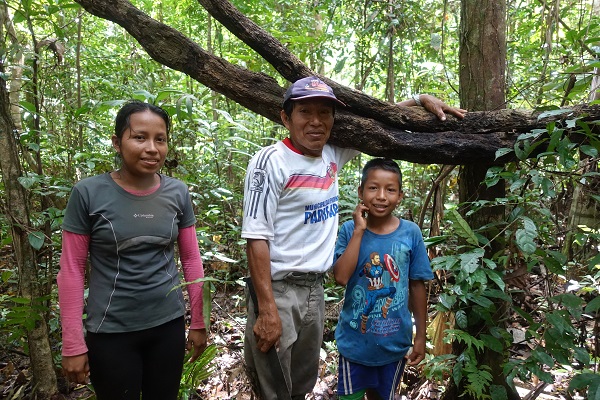
Sabina, Antonio, and Nixon
Cauper with a large ayahuasca vine.
Antonio
says that he goes into the forest about once every month, often with two or
three helpers, gathering an average of 20 bundles of vine at a time. Though we
saw no snakes during our time in the forest, we were besieged by mosquitos, and
wound up covered with very tiny ticks.
We
hiked around the forest for a few hours and encountered an endless number of
mature ayahuasca vines, most growing very closely to others. We rarely had to
walk more than 10 meters to find another vine. Several vines were as large
around as my arm, and a couple were double that thickness. Over the course of a
few hours, we easily saw several hundred tons of living vine.
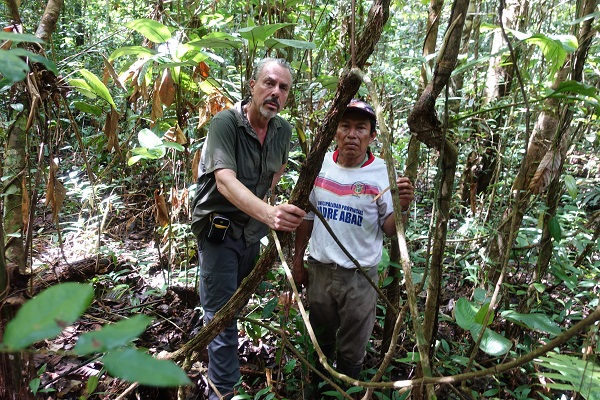
Chris Kilham, Antonio Cauper,
and a large ayahuasca vine.
When
we had seen enough, we started on the trail back toward our boat. Along the way,
we encountered a giant ungurahui (Oenocarpus bataua, Arecaceae) tree. Antonio decided to cut
the tree down, to collect the large purple drupes which are similar in
appearance and taste to açaí (Euterpe
oleracea, Arecaceae) berries, only much larger. After Antonio brought the tree
crashing down, we scooped up tens of kilos of fruits into cloth sacks, which we
carried out of the forest to the boat
Back in Junin Pablo, Nixon and Sabina had me
stand shirtless while they located and removed dozens of sand grain-sized ticks
from my torso, arms, and neck. I would find a few more when I returned home to
the United States, when the ticks had become engorged with blood and were
easier to detect.
Back in the village, Antonio asked me if I
would consider being the godfather of his granddaughter Dalixa, the daughter of
Sabina, who is only 18 years old. I asked him why he wanted me to do that, and
he replied, “because you are a kind man.” I agreed, and we headed over to his
house along the lake shore. There, Sabina prepared a bowl of water with some
malva (Malva spp., Malvaceae) blossom
hand-ground into it. Little Dalixa eyed me somewhat warily, but tolerated me
applying the water to her hair and forehead while invoking “en el nombre del padre, del madre, y
espiritu santo.” After the quick
little ceremony we nibbled on ungurahui fruits and relaxed for a while.
The day after our forest hike around Lago
Imiria, we headed back to Pucallpa, going with the current and making excellent
time.
Summary
The four trips that our team has made in the
departments of Loreto and Ucayali have given us a good current snapshot of
conditions relative to the sustainability of ayahuasca vine. A great deal of
cultivation is currently underway, and many of those with whom we spoke believe
that cultivation is the only sustainable way forward. But for now, it appears
that the supply of vine in the forest is sufficient to meet current demand.
In choosing to assess the sustainability of
ayahuasca vine in Loreto and Ucayali departments, I have taken on a project
that has no end. It is my hope that the work we have undertaken thus far will
serve as a foundation for others. Because ayahuasca is popular, and because
export of ayahuasca brew is a significant trade, pressure on wild populations
of ayahuasca vine will likely continue. At the same time, cultivation is
increasing, and I believe that we will witness a great deal more of this over
the next few years.
Many people made valuable contributions to this
project. Sergio Cam, Jaime Baca, and Kleylie Vargas made this project possible
and proved cheerful and resourceful companions. Antonio, Nixon, and Sabina
Cauper helped us greatly in the forest. Matteo Teco and other villagers in
Junin Pablo treated us with great hospitality and friendship and made us feel
welcome during our stay. I am deeply grateful for everyone who has contributed
to this work.
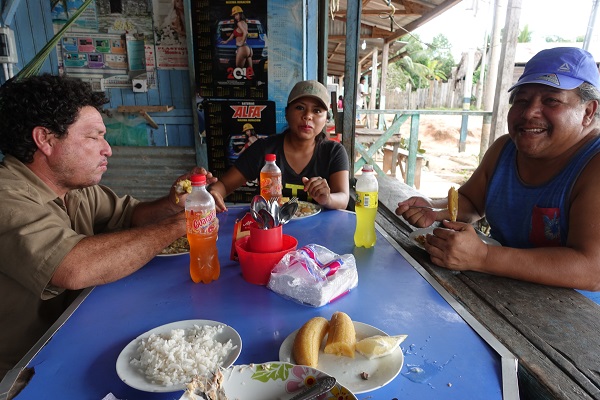
The Medicine Hunter
Peru Team: Jaime Baca, Kleylie Vargas, and Sergio Cam
Image
credits:
All images ©2019 Chris Kilham
|